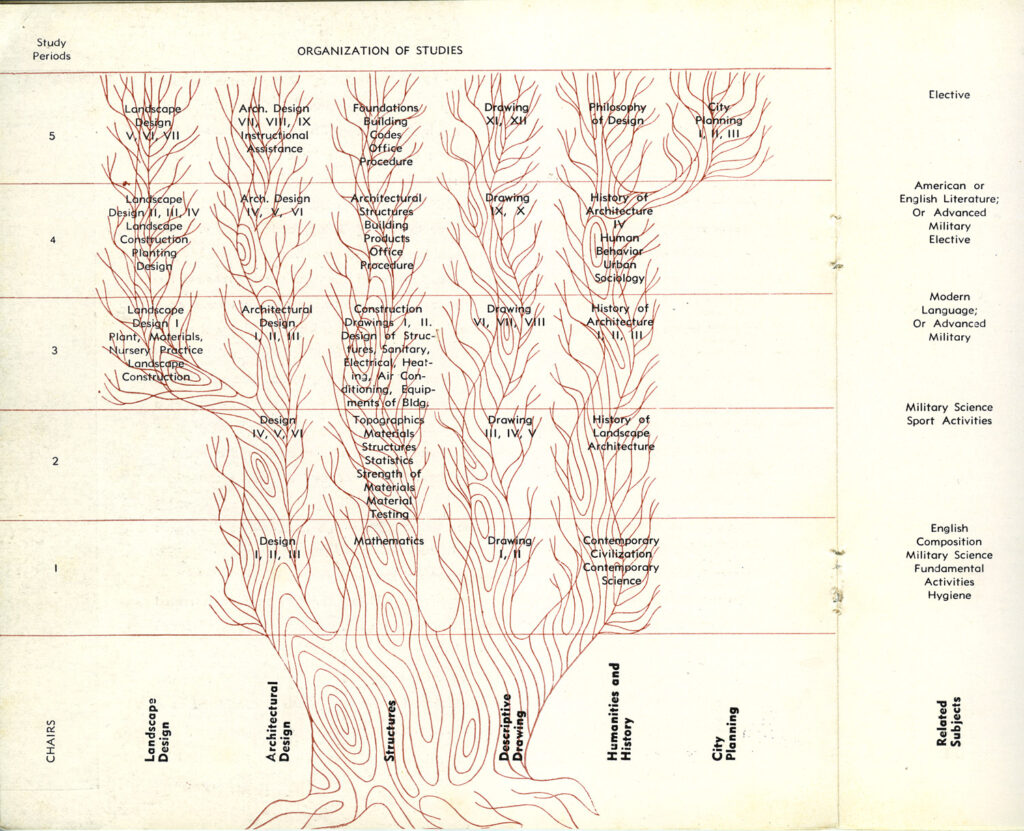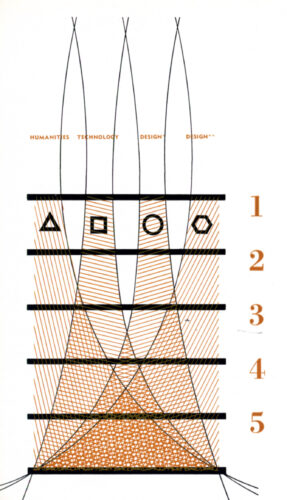Trees of Design

by Burak Erdim, PhD, associate professor of architecture
______________________
Looking through the pages of the “School of Design Bulletin” of 1949-1950, one is likely to find the “tree diagram” that illustrates the initial curriculum of the school, (Fig. 1). Instead of listing the semesters and courses year by year from top to down, similar to the way our website does now as an 8-semester display, this diagram positions the first-year courses of design, mathematics, drawing and contemporary civilization and science at the bottom and closer to the “ground,” so to speak, and near the roots of the tree which is drawn in red in the background. This “tree” is secured to the ground through the six primary subject areas of landscape design, architectural design, structures, descriptive drawing, humanities and history and city planning, which act as its roots. Second-, third- and fourth-year courses build on this foundation, providing the rungs of a ladder with which to climb the limbs and branches of the tree.

Speaking of which, the tree itself looks rather unusual as well, with an unusually thick and stocky trunk, like that of an old plane tree one might find in the middle of a village commons; or, on the pages of a children’s book by Dr. Seuss. Multiple branches spread out from this short and stocky trunk representing the multiple disciplines and areas of study that contribute to the production of expertise and disciplinary knowledge in architecture, landscape architecture and city planning. But why–one might ask–why the metaphor of a tree? Could this organization not be represented equally well with another, perhaps better-designed diagram, like the one by Eduardo Catalano, that appeared in later student publications, (Fig. 2)?

The tree certainly provides a memorable metaphor for this multidisciplinary structure, but was there something more to its symbolism and significance that may have been lost to its successors and to the way the curriculum and the organization of the school have evolved over the years? The tree diagram and the initial curriculum of the school is attributed, not to Henry L. Kamphoefner, the founding dean of the school, or any of the six faculty members he brought with him, as one might suspect, but to an entirely different camp that became associated with the school during its early years. Maciej (Matthew) and Stanislava Nowicki developed the tree diagram with their friend and collaborator, Lewis Mumford. The Nowickis had met Mumford in New York when Maciej was working on the design of the United Nations Assembly Building as the Polish representative in the international team of architects involved in the project. Mumford, a non-architect, but a prolific writer, cultural critic and a founding member of the Regional Planning Association of America, had captured Kamphoefner’s attention through his writings and lectures on architecture, modernism and regionalism. So much so that Kamphoefner asked Mumford to teach at NC State as a visiting lecturer. It was Mumford who then convinced Kamphoefner to hire Nowicki to head the school of architecture and set up the initial curriculum for the college.
Unifying the Design Disciplines
For Mumford, the world was at a significant crossroads at the end of the World War II. He viewed the rise of fascism in Europe and the American use of the atomic bomb on civilians as markers of a great fragmentation in Western culture and civilization. For him, the reunification of the design disciplines, technical education and the humanities was a fundamental way of progressively reconstructing postwar societies. The Nowickis, who had fought fascism at close range in Poland, were in complete alliance with Mumford and were implementing interdisciplinary models in higher education in the design of the Brandeis University campus when they were called upon to take the position at NC State.

Therefore, the tree and its multidisciplinary branches symbolized this particularly significant moment of reconstruction that I refer to as Postwar Constructivism, or as a “Second Modernism,” that was a departure from and a reconceptualization of prewar ideas. At the same time, the significance of the Mumford/Nowicki tree is perhaps best understood in comparison to another tree of great significance in schools of design during this period. Sir Banister Fletcher’s “Tree of Architecture” appeared in the inside cover of his seminal History of Architecture for a remarkable 60 year term from 1890 to 1954, (Fig. 3). Unlike the Tree of the College of Design, Fletcher’s tree composed of a singular primary trunk that ran, again perhaps in an equally peculiar way, all the way to the top of the tree. This telephone pole-like trunk was adorned with secondary branches which were depicted as divergences from the main trunk which represented the unyielding progression of architecture and civilization. It confined architectural and design knowledge to the study of a limited number of precedents and best practices while designating other histories, cultures and knowledges as non-historical and non-contributing to this progressive view of architecture and civilization. Even though Fletcher’s Tree of Architecture was removed from his book in 1954 due to the rise of multilateralism and internationalism in American politics and commerce, the paradigm of the study of pedigreed precedents formed a formidable bridge from the Beaux Arts System of education to the formalist camp of modernism in the United States.
Embracing Interdisciplinary Thinking
The College of Design’s Tree of Design offered a radical break from Fletcher’s Tree of Architecture by reconceptualizing design education as an interdisciplinary endeavor that brought together different pools of knowledge and viewpoints from the technical as well as the humanities disciplines. However, Maciej Nowicki’s early and unexpected death in 1950 and Mumford and Stanislava Nowicki’s departure for the University of Pennsylvania limited the impact and full dissemination of this model at NC State or elsewhere. As the College of Design faces the social, environmental and economic challenges of the 21st century in its 75th anniversary, the Tree of Design stares out from the pages of this early bulletin to capture our imagination on what interdisciplinary thinking might look like in the 21st century. Do the branches of our curriculum spread far and wide across our campus to allow us to think beyond our professional and disciplinary boundaries? Do they provide enough room for other trees and modes of knowledge and being to flourish on the same soil? I think these are simple challenges that the Tree of Design dealt to Fletcher’s Tree at the time. Here we find ourselves dealing with the very same questions.
_____________________________
This article first appeared in the 2023 issue of Designlife Magazine. Read other stories from our 75th anniversary.
- Categories:


